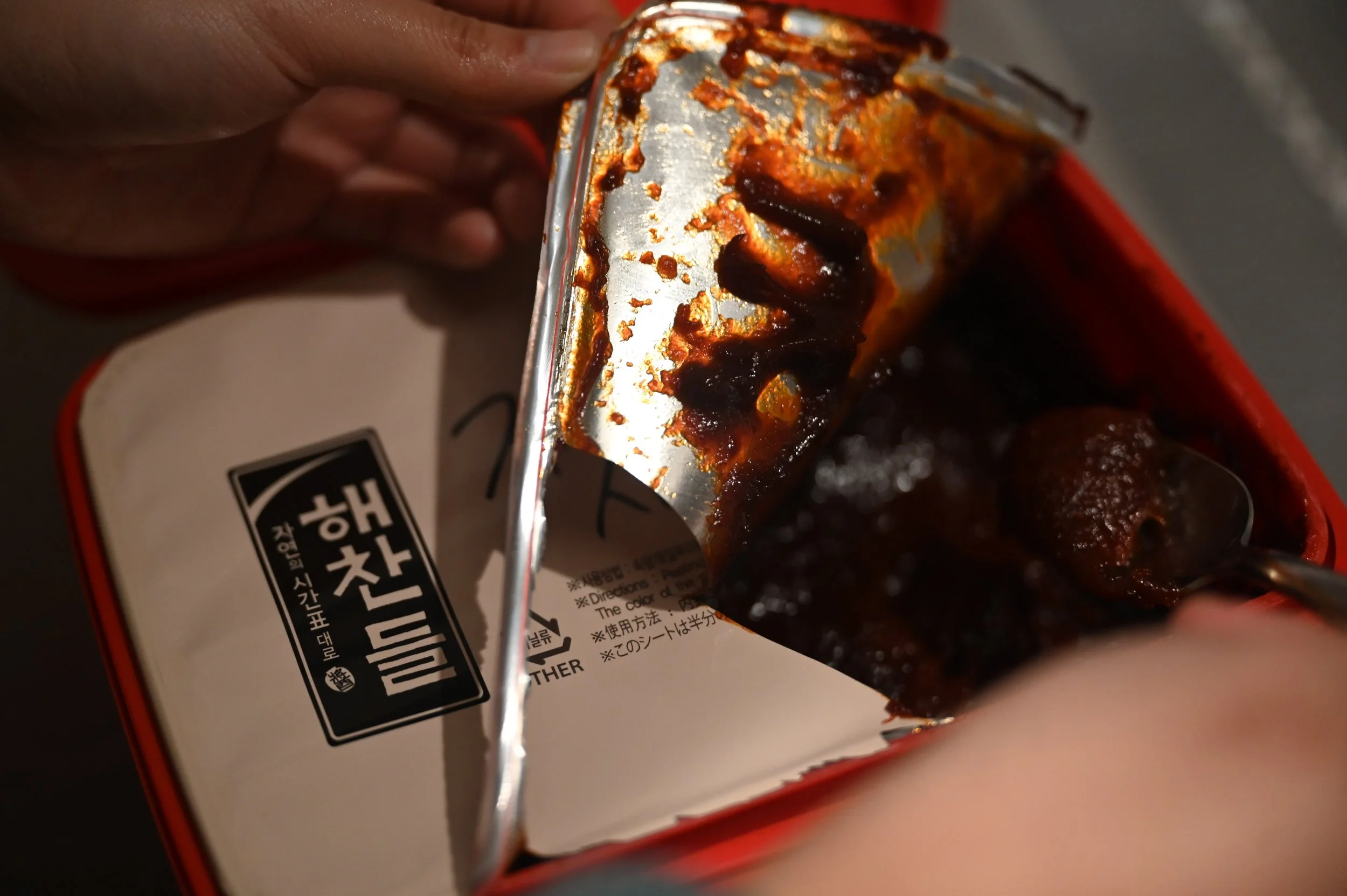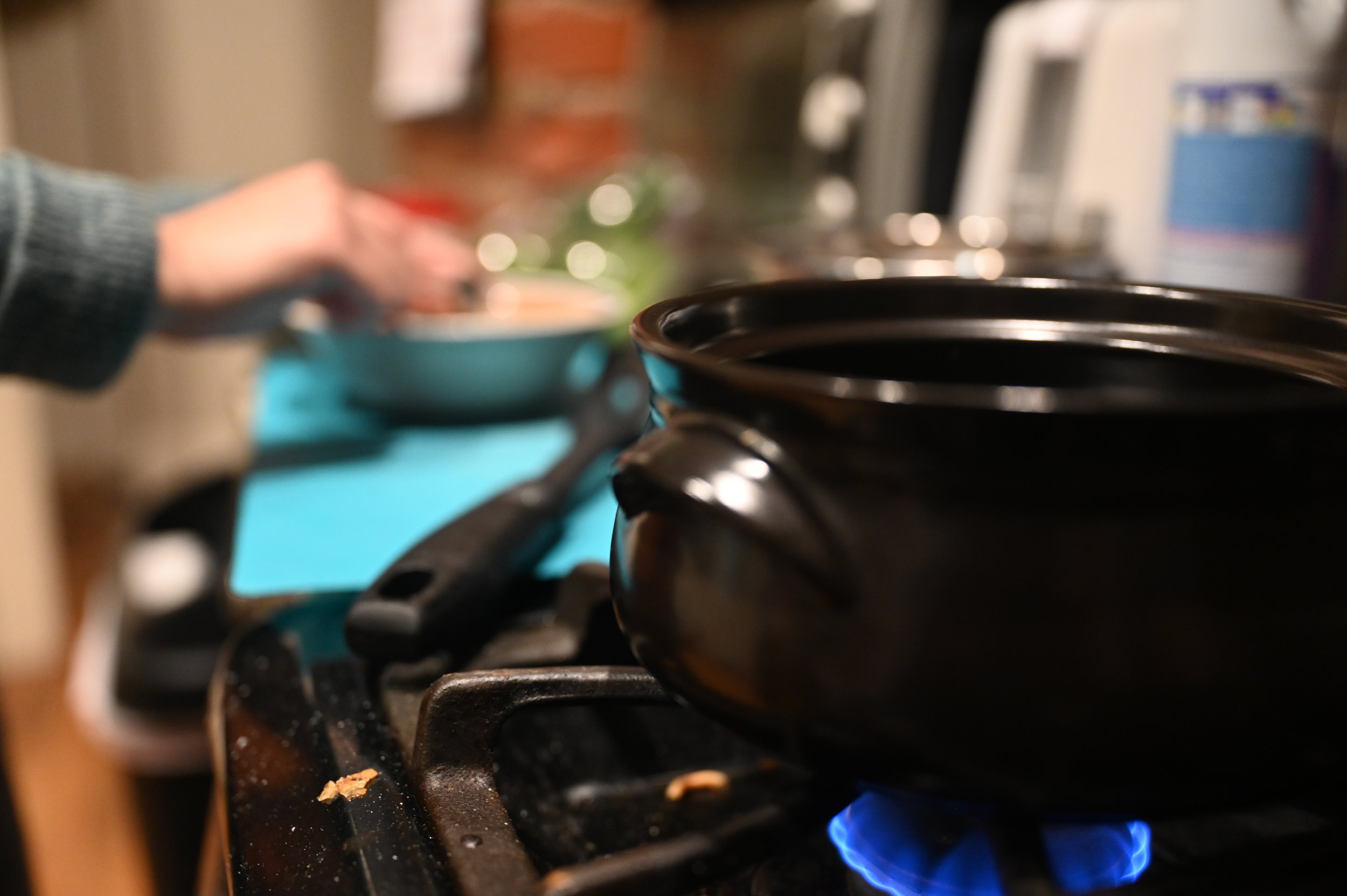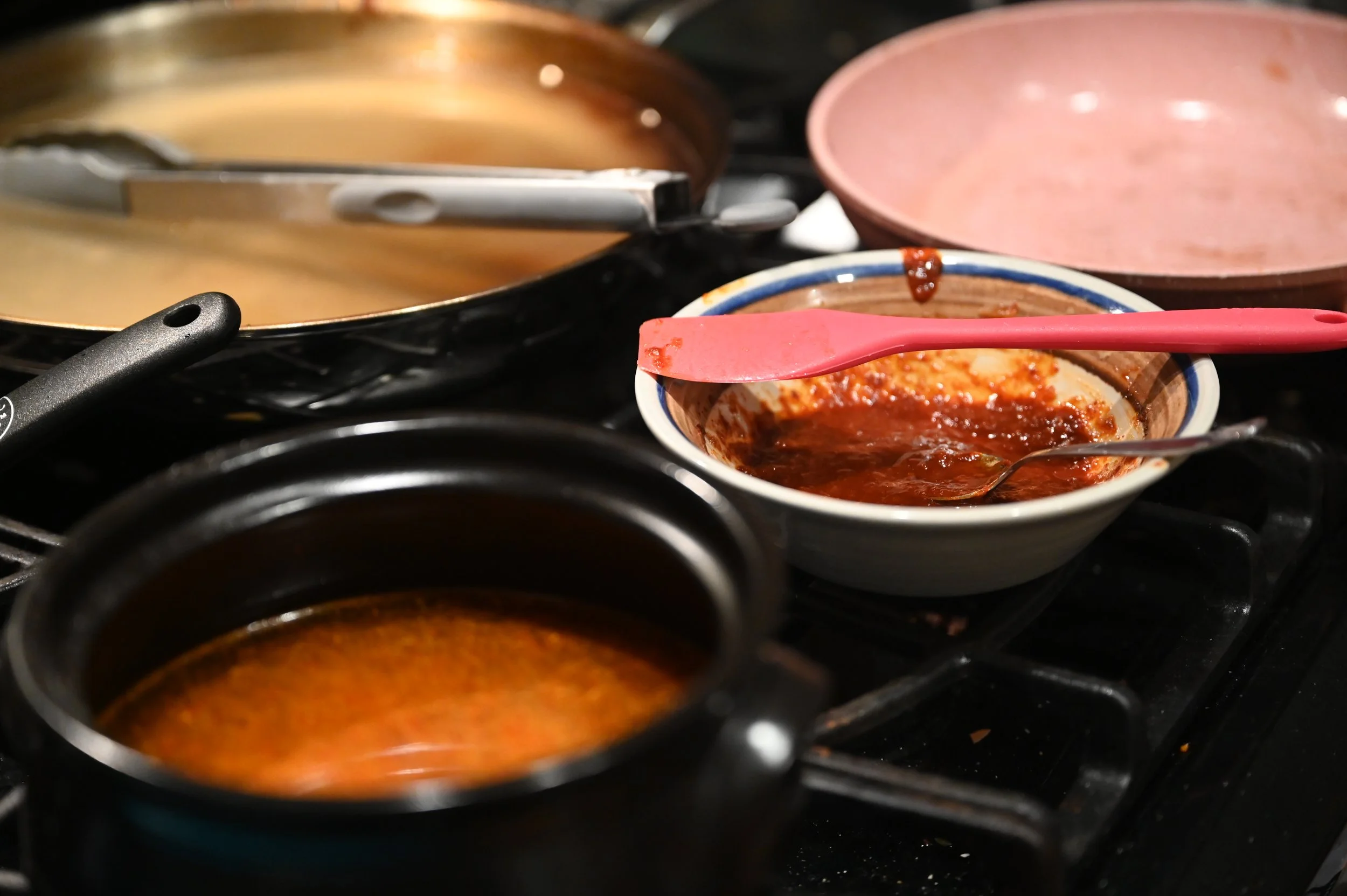An Ode to Gochujang
Original photos by Lee Rice (Nikon Z6II).
Korean-American artist and filmmaker Ellie Koo (they/them) hovers over a dolsot warming on the stove, and in one hand, mixes together a paste in a sauce bowl: soy sauce, gochugaru, sesame oil, and garlic—but something is missing. Without hesitation, Koo promptly opens the fridge to reveal a large tub of gochujang.
“There are no specific measurements—just use your heart,” Koo says before they dip a spoon into the paste and add a generous heap.
Ellie Koo mixing together different ingredients to make jjiggae paste.
Koo continues to mix, dip, and taste their mixture, letting the flavors resonate on their tongue, before deciding it needs more gochujang. Koo inherited this method of enhancing jjigae paste from the chefs in their family. “[It] involves so much intuition that can only be built through experiencing homemade Korean cuisine throughout your life. No other way for your own Korean ibmas (taste) to be built than to have tasted so much stew,” they say before dumping the mixture into their dolsot bubbling with green onion, zucchini, and mollusks.
Once a condiment exclusively used by the Korean community, gochujang has now expanded to a wider audience that's craving both heat and versatile cuisine. According to Spoonshot, a food data analytics company, interest in Korean cuisine food has spiked by 90% in the twelve months leading up to January 2022. As people consume Korean media, they’re exposed to Korean food, and there is no better way to strike the heart of Korea’s robust palette than with gochujang. It doesn’t take long to scroll online before finding some way this pepper paste is being reimagined into modern dishes, like gochujang carbonara, gochujang sloppy joes, or by home-cooks like Koo, who demonstrate for online audiences how they approach gochujang with their own inherited methods.
Gochujang is a centuries-old paste that predates kimchi. It’s an additive that promotes digestion when enjoyed with bapsang, a traditional Korean dish consisting of bap (rice), kuk (soup), and banchan (side dishes, like kimchi). Made with peppers native to Korea, it’s a paste that’s unique to the country, as Korea cultivated fermentation skills not adopted by China or Japan. The first recorded use of gochujang dates back to the 16th or early 17th century. It began as a stand-alone paste that was soon incorporated into other staples such as doenjang and ganjang (soybean paste and soy sauce). Gochujang is not just savory and spicy, it also has health benefits; it contains the digestive enzyme amylase, which breaks down proteins. Capsaicin, a compound responsible for the flavor of spicy red peppers, is another component that has antibacterial properties and aids in fat-burning. It’s a dexterous paste that can add a vibrant dimension to a soup-based dish like jjigae, or intense umami-heat at the forefront of a dish like bibimbap.
“I didn’t fall in love with it until the pandemic of 2020,” says Ann Maloney, recipes editor for the Washington Post. “I was home and trying to come up with lots of things people could do quickly and easily and [I] focused on condiments. I started to cook with it, and now it’s always in my refrigerator,” she says. Maloney’s inspiration for recipes is the common cook; after a long day of work, a home-chef needs convenience and promised delectability; gochujang is a champion of these two principles. “[Gochujang] felt complete. It didn’t feel like I had to add this and that, it’s simple and reminiscent of flavors I’ve had before,” Maloney says. “I had some thin pork chops in the freezer and very quickly broiled them, slathered them in gochujang, and it made an absolutely delicious crust—it took fifteen minutes.” She adds, “since then, I put it in marinade, I put it on burgers, I put it on chicken breasts; a better question is what I don’t put it in.”
A spoonful of gochujang rests on Koo's cutting board, accompanied by chopped scallion, white onion, and a repurposd panko crumbs jar that now holds gochugaru.
While Korean food is being upheld by a new wave of non-Korean consumers, not everyone is happy about it. A blog post by Halim Kim on gal-dem reveals a rather brash truth about its buzz spurred by Westerners. Kim writes, “although I appreciate the love and attention Korean food is receiving worldwide, I’m firmly against it becoming mainstream because of the damage popularity has had on the cuisine itself.” A strikingly true statement Kim makes is that “a food doesn’t become Korean just because you add kimchi or gochujang to it.” Kim is right—it takes a certain nuance and understanding of Korean culture and history to firmly handle ingredients like gochujang with proper homage.
Two Korean specialties that have become widely enjoyed by Westerners in recent years: Korean fried chicken and Korean barbecue. But beyond those dishes, not everything else that may incorporate ingredients like gochujang is as widely accepted. In the same post, Kim shares that Korean food is indissolubly tied to Korean history: “Hannah Bae outlines how jumeokbap (Korean rice balls) fueled protestors standing up against the military government during the 1980 Gwangju Uprising. Similarly, Buddae Jjiggae (Korean army-based stew) has a historical significance as it was originally made up of American army base scraps during the Korean war.” Once a territory pushed around by imperial powers, Korea is a country fortified by strength and grit, its food is a testament to survival. To maintain the integrity of flavor dimensions gochujang lends on a larger scale is important, should gochujang represent Korean spirit.
Koo's dolsot of sundubu jjigae is ready to be eaten with a bowl of rice on the side.
“The reality of gochujang is that it is just what it is: a flavorful paste made from red chili peppers. It can do powerful things to food, absolutely, but it’s really the rituals that come with using it that are what’s really special,” says Koo over a rich pot of soondubu jjigae. “Being able to cook, experiencing the process of it with [my family] has always brought me a sense of togetherness. And its presence is always there with the rest of us,” Koo says before coating their rice with a spoonful of stew. “It’s a good constant.”







